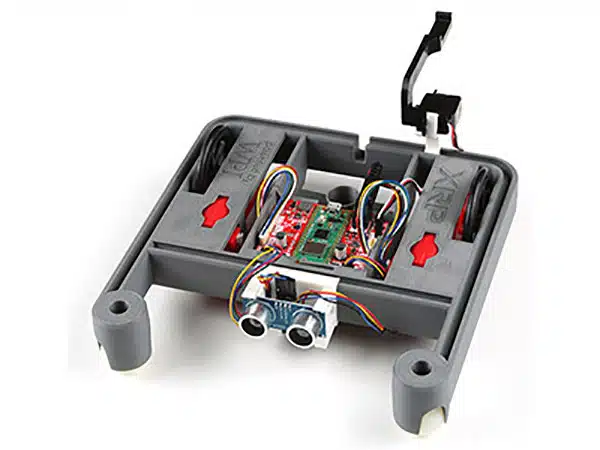¶ Overview
The XRP robot kit is an easy-to-use programmable robot for STEAM education. The standard kit has 2 wheels driven by encoded DC motors, a servo motor, a distance sensor, and a line sensor, all of which this library can control.
In addition, the XRP board can drive two extra encoded DC motors and 1 extra servo motors, and more. This library can control the second servo motor with no modifications, and can control the 3rd and 4th encoded DC motors with small modifications.

The units for blocks that control the wheels are:
- distance: mm
- speed: mm/second
The XRP library is entirely written in MicroBlocks, down to the PID control loop for the wheel motors. This means you can modify the software as you wish, including tweaking the control loop tuning parameters, providing an opportunity to learn about PID control.
¶ Summary of Blocks
For each block, there is a short description entry and a detailed block and component description. You can click on block pictures in the short description table to access the details.
¶ Block Descriptions
¶ drive at speed

Drive at the specified speed (mm/second). The speed can be different for the left and right wheels, so you can travel in an arc.
¶ drive distance

Drive straight for the specified distance (mm) at the specified speed (mm/second). Specify a negative distance (or a negative speed, but not both) to go backwards. Note: the speed cannot be zero, because the move would take forever.
¶ turn angle

Change the heading by the specified amount (degrees), moving the wheels at the specified speed (mm/sec). The robot turns about a point halfway between the wheels.
¶ stop both wheels

Stop both wheels.
¶ wait for wheels to stop

Wait for both wheels to stop.
¶ set servo to angle

Set the specified servo motor to the specified angle (deg). The standard XRP kit includes one servo motor, but the board can drive 2.
¶ read roll rate

Read roll rate (degrees/second). Positive roll tilts the left edge up.
¶ read pitch rate

Read pitch rate (degrees/second). Positive pitch tilts the nose up.
¶ read yaw rate

Read yaw rate (degrees/second). Positive yaw changes the heading to the right.
¶ read distance sensor

Read the distance sensor (cm).
¶ read left, right line sensors

Read the left and right line sensors.
¶ get the number of encoded dc motors

Get the number of encoded DC motors connected to your XRP robot. If you have more 2, modify this block to return the actual number of motors. See Driving Additional Encoded DC Motors for more information.
¶ Driving Additional Encoded DC Motors
The XRP robot kit can drive up to 4 encoded DC motors, but by default the XRP library only supports the first two (in order to speed up the feedback loop).
In order to control more motors, edit  to return 3 or 4. Then use the Encoded DC Motors library to control the additional motors, using index 3 or 4. Note that the units are are different in the Encoded DC Motors library (encoder counts instead of mm).
to return 3 or 4. Then use the Encoded DC Motors library to control the additional motors, using index 3 or 4. Note that the units are are different in the Encoded DC Motors library (encoder counts instead of mm).
You can also use any block in Encoded DC Motors to control the wheels. The left wheel is motor 1, the right wheel is motor 2. The robot moves forward when motor 1 moves in the positive direction and motor 2 moves in the negative direction.
If your additional motors need different control parameters than the main wheel motors, you can adjust the tuning parameters. See Tweaking Tuning Parameters
¶ Tweaking Tuning Parameters
The XRP wheel motors use a PID loop and signal conditioning from the Encoded DC Motors library, which in turn uses the PID library. If you wish to try different tuning parameters:
- Select
show advanced blocksin the gear menu - Right-click on the advanced block
_edcmotors_initSystemVariablesand selectshow block definitionto see and change what this block does. The tuning parameters are set starting with_edcmotors__pCoeffand ending with_edcmotors__accelEach is a list with one element per motor (the left wheel motor is motor 1, the right is motor 2).
Notes:
- If you set
_edcmotors__iCoeffto a large value, the motion is likely to go unstable. You can reduce or fix this by setting_edcmotors__dCoeffto a large value, and/or setting_edcmotors__maxIntegralto a small value. - Run this block after you change any values. You can do this manually, or press the red Stop button to reset everything (in which case this block will be automatically run next time you make a move).
¶ XRP Information
Some useful XRP facts from the manufacturer's documentation:
- The wheels have a diameter of 60 mm (2.36") and are separated by 155 mm (6.10").
- There are 585 encoder counts per revolution of the wheel (12 counts per revolution of the motor, which is then geared down).
- Distance traveled for one revolution of the wheels: 188 mm (7.42").
- Distance traveled for one encoder tick: 0.322 mm (0.0127")
¶ Credits
Many thanks to Steve Spaeth, who wrote a preliminary version of this library.